Photo / Video News & Reviews
Underwater Photography In Mexico
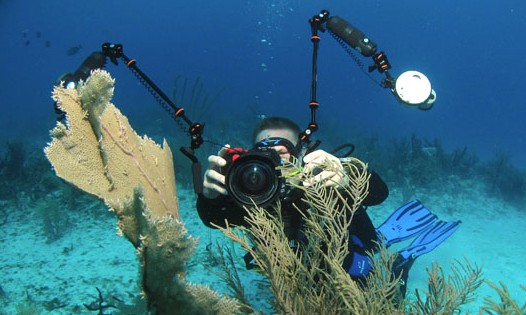
Principally there are three main areas for diving along the ‘Riviera Maya’ which have well developed diving provision:
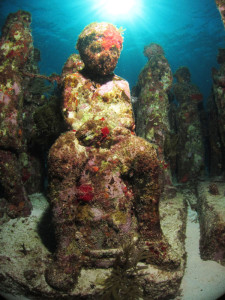
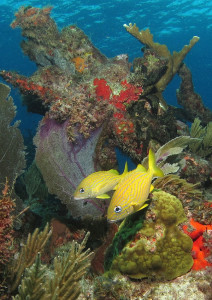 Cancun itself, with the surrounding, nearby reefs, several wrecks and La Musa (concrete statues depicting the moods of mankind – well worth a visit).
Cancun itself, with the surrounding, nearby reefs, several wrecks and La Musa (concrete statues depicting the moods of mankind – well worth a visit).
Cozumel, simply wonderful and kaleidoscopically coloured reefs, abundant marine life and sometimes, deep drop-offs.
Playa del Carmen (Playacar), reef diving, Bull Shark diving, and of course……
The Cenotes.
All of these destinations are within easy travelling distance of each other, so much variety offering ‘top ten’ tick box dives in abundance.
But the point of this little article is to chat about the frustrations and pleasures of trying to do justice in photographic form to adequately convey the colours, wildlife and clear water.
Nowadays just about every newbie diver’s first kit purchase is a camera and housing so that they can ‘capture their memories’ – come on, we all did it. Sadly the results are usually terrible and stored in electronic memories in huge numbers. I remember sitting through interminable sessions watching slides that my parents had taken to be followed by the guests showing theirs.
I’m sure the bit of me that died during those darkened room viewings has a lot to do with my subsequent vagueness and inability to concentrate.
So some time ago I set out on a mission to:
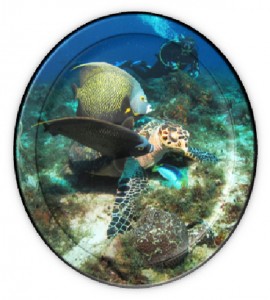 1. Not subject my friends and family to the same, showing them hundreds of not so great pictures.
1. Not subject my friends and family to the same, showing them hundreds of not so great pictures.
2. Actually try to make better images (note the use of the word image here?? Can’t call them snaps or pics any more).
3. Try not to spend too much money, inasmuch as I don’t have any.
In reverse order, the way Sports Personality of the Year does it,
3. Not spending too much money – ouch!!! I use a Canon S95 and Canon housing, INON Z240 strobe, INON wide angle ‘wet’ lenses with various arms ranging lights etc, etc (this was the cheap option!!!).
2. A fully manual camera, fill-in light and wide angle lens, good images are automatic, right ?? Wrong.
There are many sources of information regarding underwater photography written by far more learned people than me. However, one thing I’ve noticed, is that socially, photographers can attract, shall I say, ‘negative vibes’ from staff and other customers on dive trips.
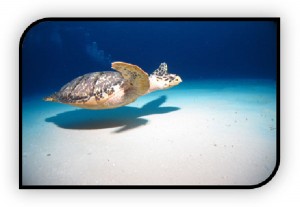 At my stage on the UW photographic learning curve I need time to take the shot. I can’t just fire off several rounds into the reef and come back with a masterpiece. My results are delivered from almost painful adjustments and experiments.
At my stage on the UW photographic learning curve I need time to take the shot. I can’t just fire off several rounds into the reef and come back with a masterpiece. My results are delivered from almost painful adjustments and experiments.
Time is of the essence when you’re a photographic grasshopper. Other divers just don’t understand your needs. The more time you spend shooting that colourful slug, the shorter their boredom threshold becomes (an opportunity for them to continue developing their buoyancy skills I say).
The dive guides in Mexico were relaxed about us hanging off the back of the dive if a tad unprepared for how distant we’d get. Once they became accustomed to our needs it worked well as it tended to separate us from the other guests.
Photographers tend to hog the best spot to see the beasties, worried that they will disappear if confronted by flailing, gasping and panting newly qualified frogpersons. This too can cause annoyance.
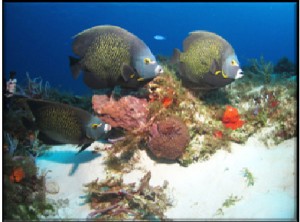 By being a little detached from the group these potential irritations were removed. Win – win!!
By being a little detached from the group these potential irritations were removed. Win – win!!
So, if like me, you need time to practice with an absolutely huge range of subjects in some of the best conditions you’re ever likely to encounter, then try Mexico.
Wildlife – and I don’t mean the mosquitoes – is massively varied and plentiful. It’s also quite tame. A little care and patience, planning and thought will allow you to approach the animals quite closely. In my experience they seem to tolerate divers more than other places I’ve visited and as such make great models. The turtles are amazing, really awesome.
Among the wide variety of life on display are huge shoals of grunts on the shallow reefs of Cancun. The lack of depth and great light give a wealth of opportunity to practice taking photographs. Truly, the quantities of fish on the reefs here need to be seen to be believed, and I’m told that they are resident all year round.
So, that’s me trying to offer some tips for the beginner.
My last point, not subjecting loved ones et al to viewings of my ‘works of art’… well, I can see where my Parents were coming from. It’s true, I am turning into my Dad.
Travel to these destinations was provided by The Scuba Place:
+44 (0) 207 644 8252
First class accommodation and world class diving are available for all levels of experience and interest. Sail-fish and Whale Shark expeditions in the summer, Bull sharks in the winter, supreme reefs and the Cenotes all year round. Couple that with the welcome Mexico offers and, well… you’ll love it.
Blogs
Diver Discovering Whale Skeletons Beneath Ice Judged World’s Best Underwater Photograph
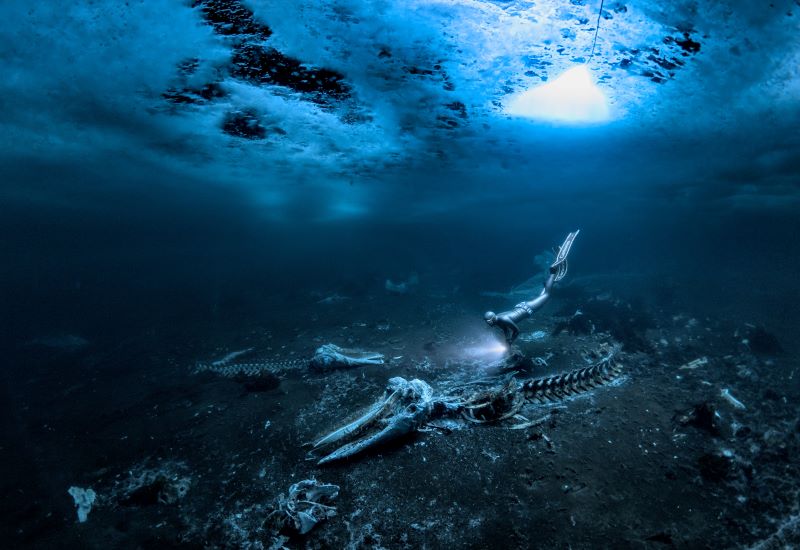
An emotive photograph showing a freediver examining the aftermath of whaling sees
Alex Dawson from Sweden named Underwater Photographer of the Year 2024. Dawson’s
photograph ‘Whale Bones’ triumphed over 6500 underwater pictures entered by underwater
photographers from around the world.
“Whale Bones was photographed in the toughest conditions,” explains chair of judging
panel Alex Mustard, “as a breath-hold diver descends below the Greenland ice sheet to bear
witness to the carcasses. The composition invites us to consider our impact on the great
creatures of this planet. Since the rise of humans, wild animals have declined by 85%. Today,
just 4% of mammals are wildlife, the remaining 96% are humans and our livestock. Our way
needs to change to find a balance with nature.”
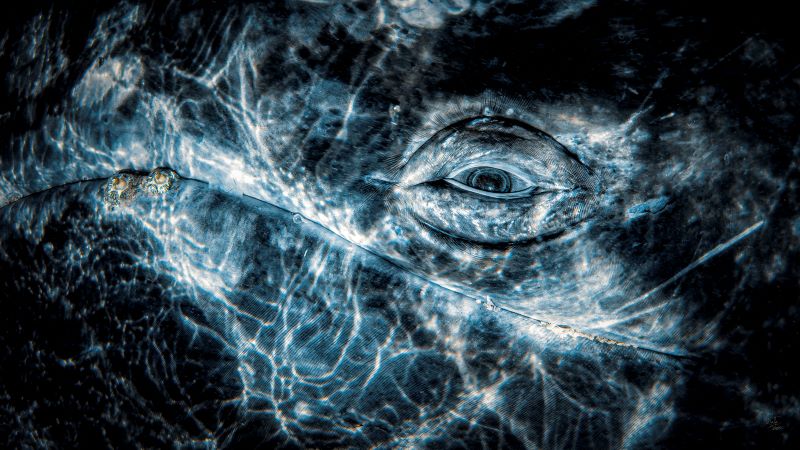
Photo: Rafael
Fernandez Caballero
Whales dominated the winning pictures this year with Spanish photographer Rafael
Fernandez Caballero winning two categories with his revealing photos of these ocean giants:
a close up of a grey whale’s eye and an action shot of a Bryde’s whale engulfing an entire bait
ball, both taken in Magdalena Bay, Baja California, Mexico. Fernandez Caballero took ‘Grey
Whale Connection’ while drifting in a small boat, holding his camera over the side in the water
to photograph the curious whale. ‘The End Of A Baitball’ required Fernandez Caballero to dive
down and be in exactly the right place at the moment the whale lunged. “The photo shows
the high speed attack,” he said, “with the whale engulfing hundreds of kilograms of sardines
in one bite — simply unforgettable to see predation on such a scale.”
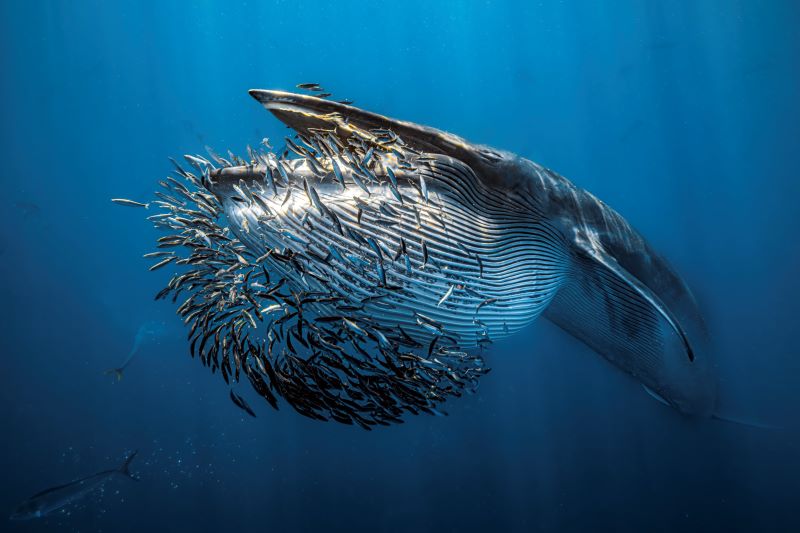
Photo: Rafael
Fernandez Caballero
Lisa Stengel from the United States was named Up & Coming Underwater Photographer of the Year 2024 for her image of a mahi-mahi catching a sardine, in Mexico. Stengel used both a very fast shutter speed and her hearing to catch the moment. “If you listen there’s an enormous amount of sound in the ocean,” she explained. “The action was too fast to see, so I honed in on the sound of the attacks with my camera to capture this special moment.”
“It is such an exciting time in underwater photography because photographers are capturing such amazing new images, by visiting new locations and using the latest cameras,”
commented judge Alex Mustard. “Until this year I’d hardly ever see a photo of a mahi mahi,
now Lisa has photographed one hunting, action that plays out in the blink of an eye.”
The Underwater Photographer of the Year contest is based in the UK, and Jenny Stock,
was named as British Underwater Photographer of the Year 2024 for her image “Star
Attraction”, which finds beauty in species of British wildlife that are often overlooked.
Exploring the west coast of Scotland, Stock explained “in the dark green depths my torch
picked out the vivid colours of a living carpet of thousands of brittle stars, each with a
different pattern. I was happily snapping away, when I spotted this purple sea urchin and I
got really excited.”
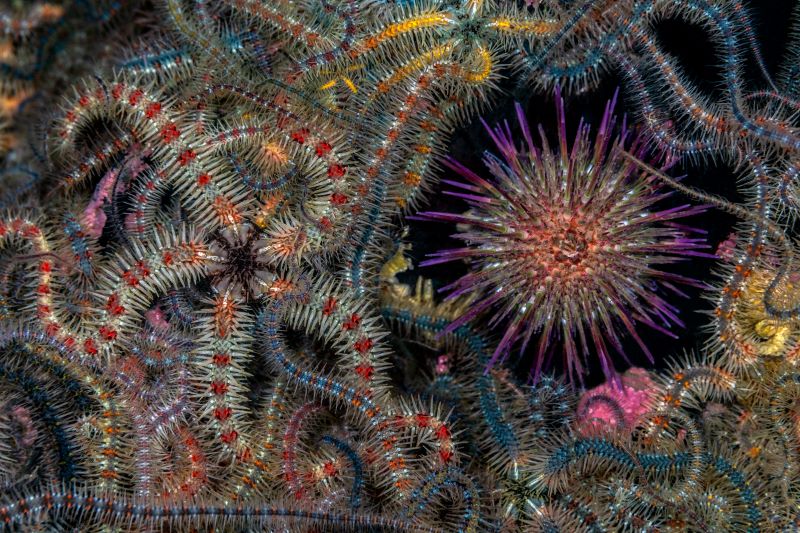
Photo: Jenny Stock
In the same contest, Portuguese photographer, Nuno Sá, was named ‘Save Our Seas
Foundation’ Marine Conservation Photographer of the Year 2024, with his photo ‘Saving
Goliath’, taken in Portugal. Sá’s photo shows beachgoers trying to save a stranded sperm
whale. The picture gives us hope that people do care and want to help the oceans, but also
warns us that bigger changes are needed. “The whale had been struck by a ship and its fate
was sealed,” explains Sá. “An estimated 20,000 whales are killed every year, and many more
injured, after being struck by ships-and few people even realise that it happens.”
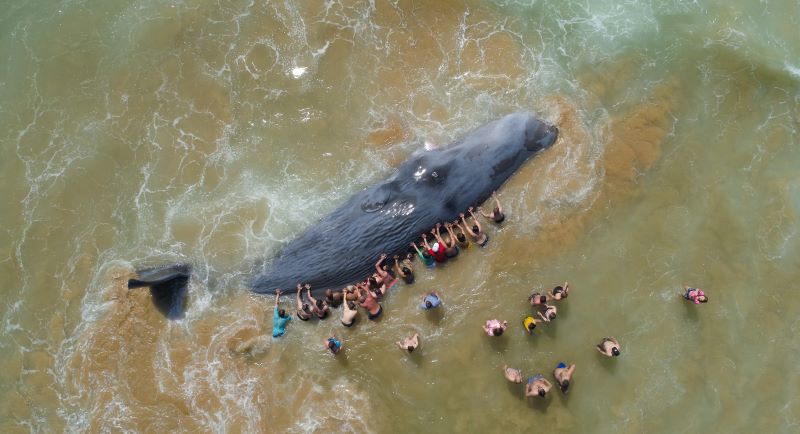
Photo: Nuno Sá
More winning images can be found at www.underwaterphotographeroftheyear.com.
About Underwater Photographer of the Year
Underwater Photographer of the Year is an annual competition, based in the UK, that celebrates photography beneath the surface of the ocean, lakes, rivers and even swimming pools, and attracts entries from all around the world. The contest has 13 categories, testing photographers with themes such as Macro, Wide Angle, Behaviour and Wreck photography, as well as four categories for photos taken specifically in British waters. The winners were announced in an award ceremony in Mayfair, London, hosted by The Crown Estate. This year’s UPY judges were experienced underwater photographers Peter Rowlands, Tobias Friedrich and Dr Alexander Mustard MBE.
Header image: Underwater Photographer of the Year 2024 winner Alex Dawson
News
World’s Best Underwater Photographers Unveil Breathtaking Images at World Shootout 2023
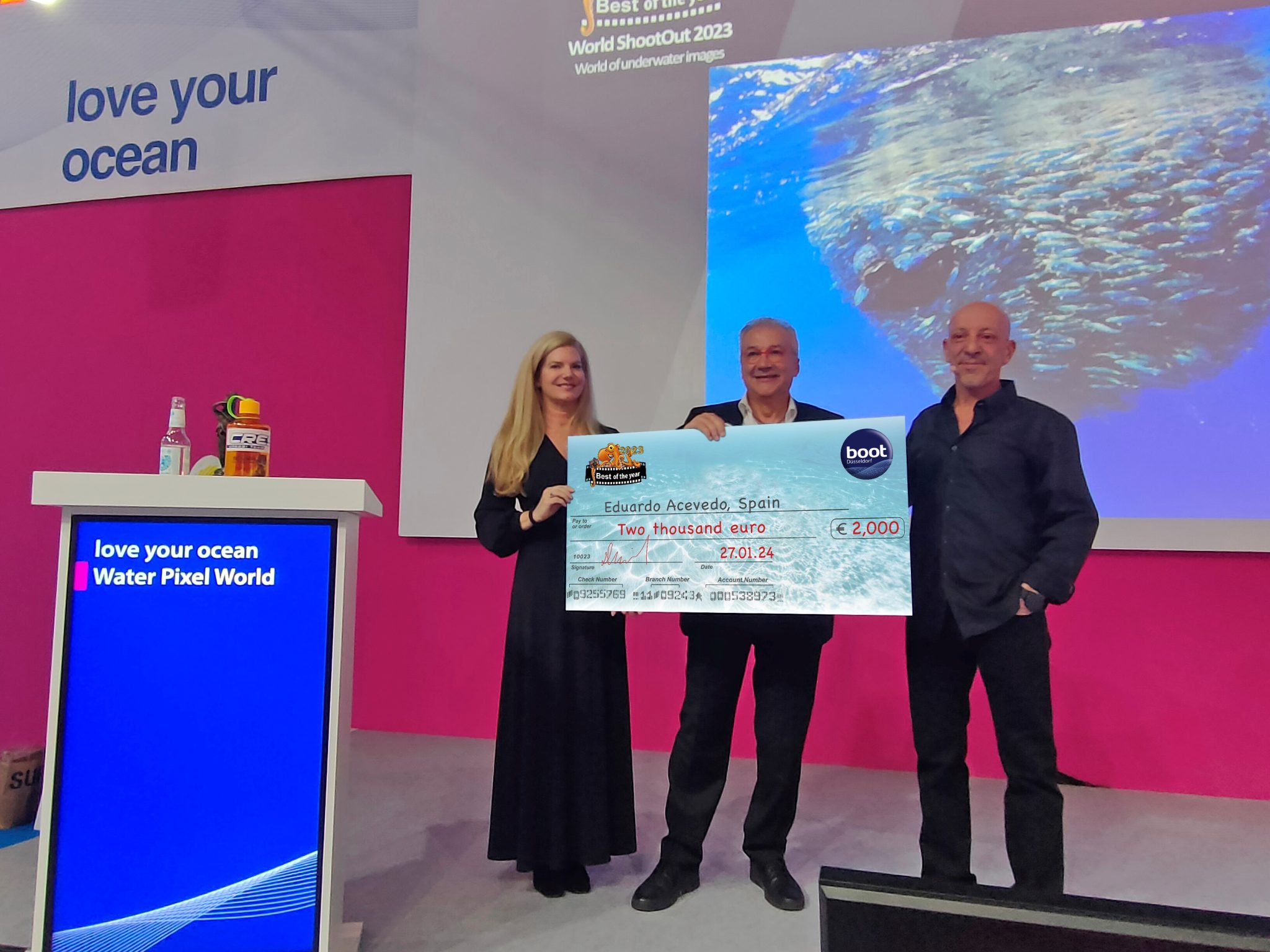
The winners of the prestigious World Shootout 2023 underwater photography competition were announced at this year’s BOOT Show, captivating audiences at the world’s largest diving and water sports exhibition in Dusseldorf, Germany. Hundreds of photographers from 54 countries competed across nine categories, pushing the boundaries of creativity and technical skill.
Grand Prize Winners
- Picture of the Year: Spanish photographer Eduardo Acevedo “secured” the top Honor with the prestigious prize the “boot Dusseldorf Director’s Prize, earning an Andromeda statuette and a €2,000 cash prize.
- Best 5 Images Portfolio: Luc Rooman from Belgium triumphed in this category, winning a dream 4-week diving trip for two to Papua New Guinea, valued at $18,900.
- Amateur Photographer: Alexandra Ceurvorst from the USA impressed the judges with her talent, taking home the 1,000 € cash prize award.
Celebrating Diversity and Innovation
This year’s competition saw 11,680 entries from 964 photographers, showcasing a remarkable spectrum of skills and perspectives. From the intricate wonders of Macro photography to the beauty of “Black Water”, the “Underwater Fashion” category added a touch of artistry and innovation, while the ever-important ” Environmental & Conservation” category served as a powerful reminder of the need to protect these fragile ecosystems.
Looking Ahead: AI and Ocean Conservation
World Shootout founder and producer David Pilosof unveiled an exciting addition for the 2024 competition: this year the Environmental category will be focusing on the impact of plastic on our oceans and future.
This category will embrace the potential of AI or other editing software as a tool to amplify the conservation message.
Entrants will submit campaigns of three original underwater photographs dealing with plastic pollution, along with their final AI assistance processing. This innovative approach encourages artistic expression while raising awareness about a critical environmental issue.
Explore the Stunning Collection
Discover the complete album of competition entries by clicking here.
For Low-resolution photos of finalist entries in eight categories, click here.
-

 News3 months ago
News3 months agoHone your underwater photography skills with Alphamarine Photography at Red Sea Diving Safari in March
-

 News3 months ago
News3 months agoCapturing Critters in Lembeh Underwater Photography Workshop 2024: Event Roundup
-

 Marine Life & Conservation Blogs3 months ago
Marine Life & Conservation Blogs3 months agoCreature Feature: Swell Sharks
-

 Blogs2 months ago
Blogs2 months agoMurex Resorts: Passport to Paradise!
-

 Blogs2 months ago
Blogs2 months agoDiver Discovering Whale Skeletons Beneath Ice Judged World’s Best Underwater Photograph
-

 Marine Life & Conservation2 months ago
Marine Life & Conservation2 months agoSave the Manatee Club launches brand new webcams at Silver Springs State Park, Florida
-

 Gear Reviews3 months ago
Gear Reviews3 months agoGear Review: Oceanic+ Dive Housing for iPhone
-

 Gear Reviews2 weeks ago
Gear Reviews2 weeks agoGEAR REVIEW – Revolutionising Diving Comfort: The Sharkskin T2 Chillproof Suit


















